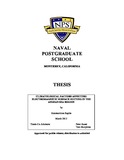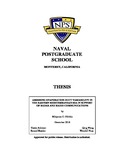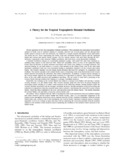Climatological Factors Affecting Electromagnetic Surface Ducting in the Aegean Sea Region

Download
Author
Raptis, Konstantinos
Date
2012-03Advisor
Guest, Peter
Murphree, Tom
Metadata
Show full item recordAbstract
We have studied the conditions that affect atmospheric electromagnetic surface ducts in the Aegean Sea region and how those conditions are related to regional and global scale climate variations. As a primary source for our calculations, we used radiosonde soundings from three different stations situated around the Aegean Sea, analyzing a 20-year period, from 1991 to 2010. We derived statistics on ducting parameters and correlated them with the seasonal means of selected climate system variables. We focused on seasonal and interannual variations in surface ducting frequency, height, and strength gradient. We found that variations in low level atmospheric moisture were a dominant factor governing variations in surface ducting conditions. The moisture variations were mainly associated with fluctuations in (1) moisture advection associated with mid-latitude cyclones in winter; and (2) local and regional evaporation in summer. The frequency of surface ducts in the summer was twice that for the winter due to larger amounts of atmospheric moisture in the summer. Variations in large-scale subsidence did not seem to significantly affect surface ducting variations. From an interannual perspective, the years that were characterized by increased moisture amounts also tended to exhibit stronger and more frequent ducting conditions for both winter and summer. We found significant correlations between Aegean surface ducting conditions and (1) local and regional moisture(r = 0.85 with significance level p = 99%); and,(2) climate variations that affect local and regional moisture, such as those associated with the Arctic Oscillation (AO), North Atlantic Oscillation (NAO), and south Asian monsoon conditions (r 0.60 with p 95%). As a by-product, we also discovered significant correlations (ranging from r = 0.67 to r = 0.96 with p 95%) between ducting parameters and the vertical resolution of the radiosonde data, indicating that differences in data collection procedures need to be accounted for when conducting ducting analyses based on radiosonde data.
Collections
Related items
Showing items related by title, author, creator and subject.
-
Assessing evaporation duct variability in the Eastern Mediterranean Sea in support of radar and radio communications
Gürbüz, Süleyman C. (Monterey, California. Naval Postgraduate School, 2016-12);Electro-magnetic (EM) propagation is greatly affected by atmospheric conditions. Although this subject has been an active area of research, a comprehensive evaporation ducting study for the Eastern Mediterranean Sea does ... -
Annual cycle of Southeast Asia - Maritime Continent rainfall and the asymmetric monsoon transition
Chang, C.-P.; Wang, Z.; McBride, J.; Liu, C. H. (2005);In general the Bay of Bengal, Indochina Peninsula and Philippines are in the Asian summer monsoon regime while the Maritime Continent experiences a wet monsoon during boreal winter and a dry season during boreal summer. ... -
A Theory for the Tropical Tropospheric Biennial Oscillation
Chang, C.-P.; Li, Tim (2000-07-15);The key questions of how the tropospheric biennial oscillation (TBO) maintains the same phase from northern summer in South Asia to southern summer in Australia, and how the reversed phase can last through three locally ...


 12Mar_Raptis.pdf (8.002Mb)
12Mar_Raptis.pdf (8.002Mb)

